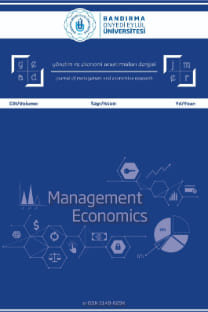Zamana bağlı müşteri geliş oranlarına sahip sistemlerin performans analizi: Banka uygulaması
Performance analysis of the systems with time-dependent arrivals: Application of abank branch
___
- Alfa, A.S. ve Chakravarthy, S.A. (1994) A Discrete Queue with the Markovian Arrival Process and Phase Type Primary and Secondary Services, Communications in Statistics - Stochastic Models , 10(2): 437 -451.
- Alfa, A.S. ve Neuts, M.F. (1995) Modelling Vehicular Traffic Using the Discrete Time Markovian Arrival Process, Transportation Science, 29(2): 109- 117.
- Alfa, A.S., Chakravarthy, S.A. ve Dolhun K.L. (1995) A Discrete Single Server queue with Markovian Arrival Process and Phase Type Group Services, Journal of Applied Mathematics and Stochastic Analysis , 8(2): 151 - 176.
- Brahimi, M. ve Worthington, D.J. (1991) The Finite Capacity Multi- Server Queue with Inhomogeneous Arrival Rate Ad Discrete Service Time Distribution And its Application To Continuous Service Time Problem, European Journal of Operational Research, 50(3): 310- 324.
- Erlang, A.K. (1918) Solution of Some Problems in The Theory of Probabilities of Significance in Automatic Telephone Exchanges, The Post Office Electrical Engineers , 10: 189 - 197.
- Green, L.V. ve Kolesar, P.J. (1991) The Pointwise Stationary Approximation for Queues with Nonstationary Arrivals, Management Science, 37(1): 84 -97.
- Green, L.V. ve Kolesar, P.J. (1995) On the Accuracy of the Simple Peak Hour Approximation for Markovian Queues, Management Science, 37(1): 84- 97.
- Green, L.V., Kolesar, P.J. ve Svorono s, A. (1991) Some effects of Nonstationary on Multiserver Markovian Queueing Systems, Operations Research, 39(3): 502- 511.
- Green, L.V., Kolesar, P.J. ve Whitt W. (2007) Coping with time- varying Demand when Setting Staffing Requirements for A Service Sy stem, Production and Operations Management , 16(1): 13- 39.
- Gross, D., Shortle, J.F., Thompson, J.M. ve Harris, C.M. (2008) Fundamentals of Queueing Theory, Wiley Series in Probability and Statistics, John Wiley & Sons, Inc., Fourth Edition, New Jersey.
- Hall, R., Belson, D., Murali, P. ve Dessouky, M. (2006) Modeling patient flows through the healthcare system, Patient Flow: Reducing Delay in Healthcare Delivery, International Series in Operations Research & Management Science, 91: 211 -252.
- Ingolfsson, A.E., Akhmetshina, S. ve Budge, Y.L. (2007) A survey and Experimental Comparison of Service Level Approximation Methods For Non- Stationary M(t)/M/s(t) queueing systems with exhaustive discipline, INFORMS Journal on Computing, 19(2): 201 214.
- Jackson, J. R. (1957) Networks of Waiting Lines, Operations Research, 5: 518 -521.
- Jennings, O.B., Mandelbaum, A., Massey, W.A. ve Whitt, W. (1996) Server Staffing to Meet Time- Varying Demand, Management Science, 42(10): 1383- 1394.
- Kelly, F.P. (1975) Networks of Queues with Customer of Different Types Journal of Applied Probability, 12(3): 542- 554.
- Meislig, T. (1958) Dicrete-T ime Queuing Theory, Operations Research, 6(1): 96- 105.
- Neuts, M.F. (1981) Matrix Geometric Solutions in Stochastic Models - An Algorithmic Approach, John Hopkins University Press, Baltimore.
- Taha, H.A. (2007) Operations Research, Pearson Education, Inc., Eight Edition, New Jersey Wall, A. (1995) Extending the Scope of Discrete Time Models to Provide Practical Results for Continuous Time Queueing Systems , PhD Thesis, University of Lancaster, UK.
- Wall, A. ve Worthington, D.J (1999) Using the Discrete Time Modelling Approach to Evaluate The Time- Dependent Behaviour of Queuing Systems, Journal of the Operational Research Society, 50(8): 777- 788 .
- Whitt, W. (1983) The Queueing Network Analyzer, The Bell Systems Technical Journal, 62(9): 2779 -2815.
- Whitt, W. (1991) The Pointwise Stationary Approximation for M t/ M t/s queues is asymptotically correct as the rates increase, Management Science, 37(3): 307 -314.
- Whitt, W. (2007) What you should Know about Queueing Models to Set Staffing Requirements in Service Systems, Naval Research Logistics , 54(5): 476 -484.
- ISSN: 2148-029X
- Yayın Aralığı: 4
- Başlangıç: 2013
- Yayıncı: Bandırma Onyedi Eylül Üniversitesi İ.İ.B.F.
İbrahim YILDIZ, Cem KAHYA, Abdullah NARALAN
Döviz kuru belirsizliğinin özel sabit sermaye yatırımlarına etkisi: Türkiye örneği
Oktay ÖKSÜZLER, M. Fatih EKİNCİ
Bn Teymiyye'nin siyaset, hukuk ve iktisat teorisi
Avrupa birliği bölgesel kalkınma mali yardımlarının Türkiye açısından değerlendirilmesi
Burcu SAVRUL KILINÇ, Alp ÖZEL, Cüneyt KILIÇ
Zamana bağlı müşteri geliş oranlarına sahip sistemlerin performans analizi: Banka uygulaması
